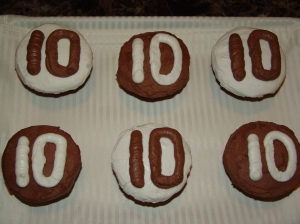There’s something special about today, and if you’re geeky enough, you might just know what. It turns out that today’s date, October 10, 2010 can be expressed as a binary number by using the DD/MM/YY format. This gives us the text string 10/10/10. In honor of this calendar quirk, I would like to offer some reading suggestions that celebrate the history of the computer and the radical ways in which it has altered human society.
The Books
“Engines of the Mind” by Joel Shurkin, is an exhaustively well-researched look at the early development of computers and contains particularly fascinating portraits of visionaries such as Charles Babbage, Herman Hollerith, Eckert and Mauchly, and John von Neumann. It is the definitive history of computers from Babbage’s Victorian era concept of a steam-driven “Difference Engine” to the vast, room-filling mainframes of the late 1960s. Shurkin’s book was not intended to cover the development of pc’s nor does it address the rise of the internet and the global paradigm shift that the wide-spread adoption of these technologies has fueled. For more on these topics, I recommend Paul Freiberger and Michael Swaine’s Fire in the Valley: The Making of The Personal Computer” which covers the growth of personal computing from the domain of quirky hobbyists like the members of “The Homebrew Computer Club” (including Bob Marsh, George Morrow, Adam Osborne, and Apple founders Steve Jobs and Steve Wozniak)to the multi-billion dollar industry it is today. Also of note is “Who Controls the Internet? Illusions of a Borderless World” by Jack Goldsmith and Tim Wu. This book, by two legal scholars traces the evolution of legal and social power on the web. As the saying goes: information wants to be free, but this startling analysis proves that it is subject to many of the same controls online as it is in more traditional formats. Red-tape, censorship and litigiousness abound in cyberspace as governments and corporations attempt to lock-down the generative, collaborative and somewhat anarchistic nature of the internet.
The Food

Black and White Binary Cupcakes:
Any celebration of Binary Day should include a clear reference to the dualistic nature of the notational form. The binary number system (otherwise known as base 2) represents values using two symbols, typically 0 and 1. Computers call these bits. A bit is either off (0) or on (1). When arranged in sets of 8 bits (1 byte) 256 values can be represented (0-255).Using an ASCII chart, these values can be mapped to characters and text can be stored. It’s not magic, it’s just math!
Thus inspired, I created a set of chocolate and vanilla frosted cupcakes emblazoned with today’s date. In this case I have chosen to represent those mutually exclusive states as being either “Black or White.”
Finally, for those of you who are REALLY geeky, I offer the following tidbit: if one calculates the base-10 value of the binary number 101010, it turns out to be “42”, which is, of course the much-beloved punch-line to the question “What is the Answer to the Ultimate Question of Life, the Universe and Everything?” put forth in Douglas Adams’ cult classic book “The Hitchhiker’s Guide to the Universe.”
And that, dear readers, is worthy of a celebration all it’s own!
The Recipes
Buttermilk Cake Layers: from Nick Malgieri’s “Perfect Cakes”
makes two 9-inch round layers OR two 6-inch layers and six cupcakes
- 2 3/4 cups all-purpose flour
- 1/2 teaspoon salt
- 1/2 teaspoon baking soda
- 1/2 pound unsalted butter, softened
- 2 cups sugar
- 2 teaspoons vanilla extract
- 4 large eggs
- 1 cup buttermilk
Lightly grease and flour pans. Position rack in the middle of oven and preheat to 350F.
Stir together the flour, baking soda, and salt in a bowl, mixing well.
Place the butter and sugar in the bowl of a heavy-duty mixer fitted with the paddle attachment and beat on medium speed for about 5 minutes, or until very soft and light. Beat in the vanilla, then beat in the eggs one at a atime, beating well after each addition.
Reduce the speed to low and beat in one-third of the flour mixture, then half the uttermilk, stopping and scraping down the bowl and beater after each addition. Beat in another third of the flour, then the remaining buttermilk, stopping and scraping again. Finally, beat in the remaining flour mixture.
Scrape the bowl well with a spatula. Pour the batter into the prepared pans and smooth the tops.
Bake the layer for about 30 to 35 minutes, until they are well risen and firm and a toothpick inserted in the center emerges clean. Cool cake in the pans on racks for 5 minutes, then unmold onto racks to finish cooling.
Binary Buttercreams
- ¼ cup softened butter
- ¼ shortening
- 1 1lb box confectioners sugar
- 3 tbsp water
- 1 cup bittersweet chocolate pieces
- ½ cup heavy cream
- 2 tsp vanilla extract
Place chocolate chips and cream in microwave safe container and warm on high until chips are melted, 1 to 1 ½ minutes. Stir to blend until mixture is smooth and shiny – refrigerate until thoroughly cooled – the mixture (now called a ganache) will stiffen as it rests.
Using a stand mixer or hand mixer, cream together butter and shortening. Add the confectioners sugar and mix on medium, adding the vanilla extract and up to 3 Tbsp water to achieve a spreadable consistency.
Separate the buttercream – reserving 2/3 of the batch to use as the vanilla portion. Into the remaining 1/3 of the frosting, mix the cooled ganache – blending well until the consistency and color is even.
Use to frost 2 9-inch cake layers, or up to 2 dozen cupcakes in contrasting patterns.

